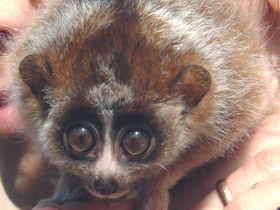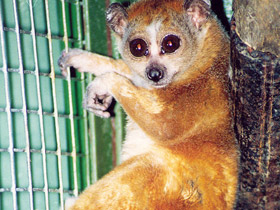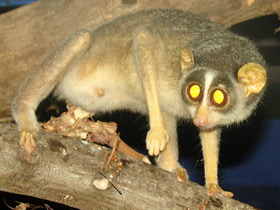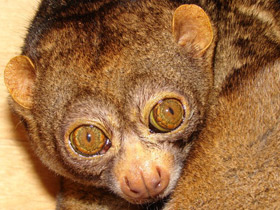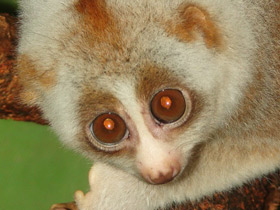The family Lorisidae
Lorisidae (or sometimes Loridae) is a family of strepsirrhine primates. The lorisids are all slim arboreal animals and comprise the lorises, pottos and angwantibos. Lorisids live in tropical, central Africa as well as in south and southeast Asia.
Classification
There are five genera and sixteen species of lorisid.
Order Primates
- Suborder Strepsirrhini: non-tarsier prosimians:
- Infraorder Lemuriformes:
- Superfamily Lemuroidea;
- Superfamily Lorisoidea:
- Family Lorisidae:
- Subfamily Perodicticinae:
- Genus Arctocebus, angwantibos;
- Genus Perodicticus, pottos;
- Subfamily Lorisinae:
- Genus Loris, slender lorises;
- Genus Nycticebus, slow lorises;
- Genus Xanthonycticebus, pygmy slow loris;
- Family Galagidae: galagos;
- Suborder Haplorrhini: tarsiers, monkeys and apes.
Particularities and behaviour
Lorisids (Lorisidae) are a family of strepsirrhine primates.
For a long time the Lorisidae were thought to be lazy due to their extreme slowness of movement. It was not until 1766 that Buffon, a French naturalist, established that they are actually half monkeys. They move very slowly and carefully, changing legs and standing still for a long time at the slightest sign of trouble. This makes them invisible to enemies and potential prey.
A special grip structure - the first toe is almost 180 degrees to the rest - provides a powerful grip and Lorisidae can hang on to a branch using their hindquarters for a long time. This is also made possible by a special structure of blood vessels in the wrists and ankles, known as the "wonder net". It provides the muscles of the limbs with an abundant supply of oxygenated blood and removes metabolic waste products (e.g. lactic acid), which can cause cramps and muscle damage. Lorisidae almost never leave the treetops. They move on four limbs, walking slowly along the branches and stretching between the outermost branches when moving from one tree to another. When hunting, however, these charming little animals are capable of a quick attack, during which they lunge forward to grab their prey with both hands.
Appearance
The fur of the Lorisidae is thick and soft, grey or brown in colour. They have large eyes, typical of nocturnal animals, small ears hidden in the fur and a short tail. All toes have nails, except the second toe, which has a "cosmetic" claw for cleaning the fur.
Nutrition
Surprisingly, these cunning, slow-moving animals have adapted to eat the most unpalatable and poisonous invertebrates, which no other animal can eat. They find sluggish or immobile insects by smell, and will happily eat even poisonous beetles, ants, millipedes and caterpillars covered with thick irritating or poisonous hairs.
The metabolism of lorises is very slow (40 times slower than would be expected for animals of their size), but in this case it "works in their favour", as they always have time to neutralise poisonous chemicals in the gut before they take effect. However, lorises also do not reject more palatable foods: bird eggs, lizards and fruit, nectar, resin and even small bats and rodents.
Behavior and ecology
Lorisids are nocturnal and arboreal. Unlike the closely related galagos, lorisids never jump. Some have slow deliberate movements, whilst others can move with some speed across branches. It was previously thought that all lorisids moved slowly, but investigations using red light proved this to be wrong. Nonetheless, even the faster species freeze or move slowly if they hear or see any potential predator. This habit of remaining motionless whilst in danger is successful only because of the leafy environment of their jungle home, which helps to conceal their true position. With their strong hands they clasp at the branches and cannot be removed without significant force. Most lorisids are solitary or live in small family groups.
Slow lorises from southeast Asia produce a secretion from their brachial gland (a scent gland on the upper arm, between the axilla and elbow), that is licked and mixed with their saliva to form a toxin which may be used for defense. The red slender loris (Loris tardigradus) from India also possesses brachial glands, but it is uncertain whether they also synthesize the toxin. The potto (Perodicticus potto) is thought to lack brachial glands, though it produces similar toxic excretions with its anal glands.
Lorisids have a gestation period of four to six months and give birth to two young. These often clasp themselves to the belly of the mother or wait in nests, while the mother goes to search for food. After three to nine months - depending on the species - they are weaned and are fully mature within 10 to 18 months. The life expectancy of lorises can be to up to 20 years.
Lorisids consume insects, bird eggs and small vertebrates as well as fruits and gums.

















